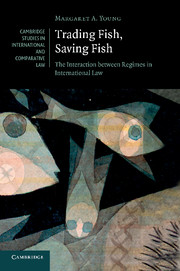Book contents
- Frontmatter
- Contents
- Foreword
- Acknowledgements
- Table of cases
- Table of Conventions, Declarations and procedures
- List of abbreviations
- Part I Trading Fish, Saving Fish
- Chapter 1 Introduction
- Chapter 2 Relevant laws and institutions: an overview
- Part II Selected Case Studies
- Part III Towards Regime Interaction
- Appendices
- Bibliography
- Index
- CAMBRIDGE STUDIES IN INTERNATIONAL AND COMPARATIVE LAW
- References
Chapter 2 - Relevant laws and institutions: an overview
Published online by Cambridge University Press: 28 April 2011
- Frontmatter
- Contents
- Foreword
- Acknowledgements
- Table of cases
- Table of Conventions, Declarations and procedures
- List of abbreviations
- Part I Trading Fish, Saving Fish
- Chapter 1 Introduction
- Chapter 2 Relevant laws and institutions: an overview
- Part II Selected Case Studies
- Part III Towards Regime Interaction
- Appendices
- Bibliography
- Index
- CAMBRIDGE STUDIES IN INTERNATIONAL AND COMPARATIVE LAW
- References
Summary
Ensuring the sustainable development of the oceans requires effective coordination and cooperation, including at the global and regional levels, between relevant bodies …
This chapter describes the international laws and institutions that have historic and emerging relevance to the trade-related aspects of fisheries. Within the law of the sea, various instruments, including UNCLOS, the Fish Stocks Agreement and voluntary FAO codes, seek to govern fisheries management. These approaches meet the definition of legal regimes offered in Chapter 1, and the first part describes first UNCLOS and the EEZ regime, then high seas, fish stocks and regional regimes and then the FAO fisheries management regime. The chapter then moves to examine international environmental law. The CITES regime is increasingly relevant to the trade in endangered marine species, while the Convention on Migratory Species addresses conservation obligations of range states and the Convention on Biological Diversity manages marine living resources. The final part of the chapter considers the WTO regime. In promoting liberalised international trade, the WTO covered agreements affect the trade in fish and fish products in many ways, and new disciplines on fisheries subsidies promise to focus trade law on fisheries sustainability in the future. In my consideration of these selected regimes within the law of the sea, international environmental law and international trade law, I also examine ways in which these areas of law ‘look outwards’ to other areas of international law.
- Type
- Chapter
- Information
- Trading Fish, Saving FishThe Interaction between Regimes in International Law, pp. 32 - 82Publisher: Cambridge University PressPrint publication year: 2011
References
- 1
- Cited by



